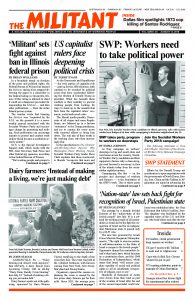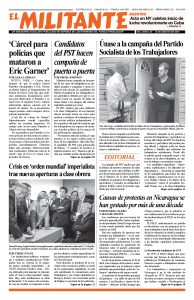August 9, 1993
PINCKNEYVILLE, Illinois — As the strike battle between the United Mine Workers of America and Bituminous Coal Operators Association expands, the miners are reaching out to win new support. There are now 16,000 miners striking in seven states — Indiana, Illinois, Kentucky, Ohio, Pennsylvania, Virginia, and West Virginia.
Five thousand camouflage-clad striking miners, their families, and supporters joined an “international labor rally” here July 15 to support the strike. Two thousand had participated in a similar rally in Waynesburg, Pennsylvania, a day earlier.
More than 100 locked-out members of the Allied Industrial Workers union from Decatur, Illinois, and 50 members of the International Brotherhood of Electrical Workers locked out from Central Illinois Power Service plants joined the Pinckneyville action.
August 16, 1968
MEXICO CITY, Aug. 2 — More than 125,000 marched here yesterday in a protest demonstration against the government’s brutal police attacks on the students, beginning at Vocational School Five.
The repression is blind, incoherent and exhibits a virulence not seen in the 10 years since the army broke the railway workers’ strike.
The march took place despite considerable efforts by the papers to sabotage it. The demonstration was made up primarily of university students, as well as other sectors of the population.
The demonstration made a circuit of the city of more than seven miles. The march was not allowed to approach the center of the city.
To enforce this ban, the government deployed military forces with tanks and heavy equipment.
August 14, 1943
There was remarkable unanimity of opinion among the well-known Negro leaders and in the Negro press during and after the August 1-2 outbreak in Harlem. Practically every one of them — whether conservative, liberal, Stalinist or “radical” — joined in denouncing thousands of Harlemites as hoodlums, vandals, irresponsible elements, etc.
Virtually all the Negro papers hailed the behavior of the New York police — the same police whose brutality to Negroes was one of the chief causes of the outbreak. They seem highly elated and relieved that “only” six died, most of them at the hands of the police.
These Negro leaders and editorial writers knew, as most of them have since half-admitted, that the Harlem outbreak was a protest against the oppressive Jim Crow conditions to which Negro people are subjected in even the “most liberal city in the country.”

